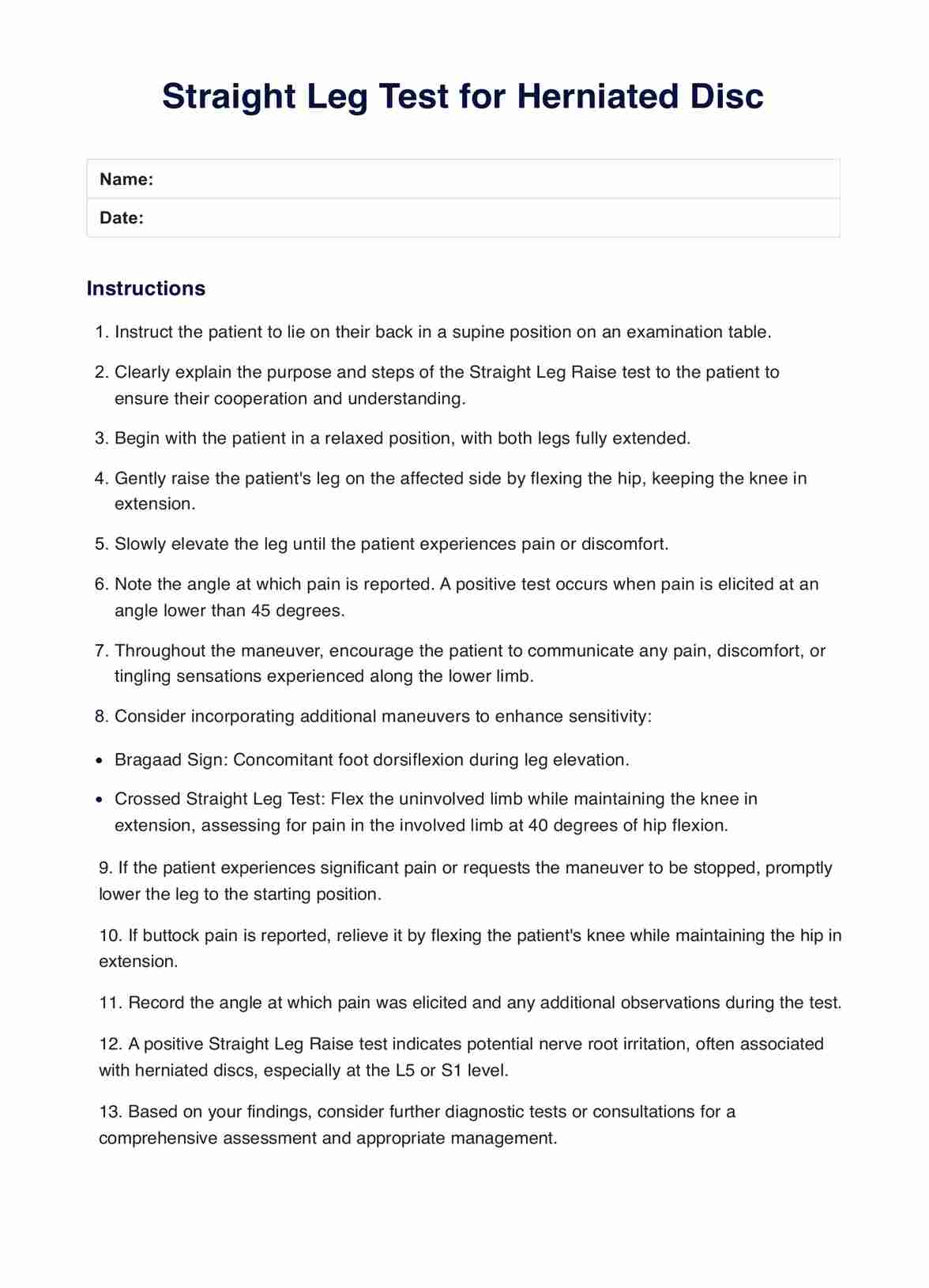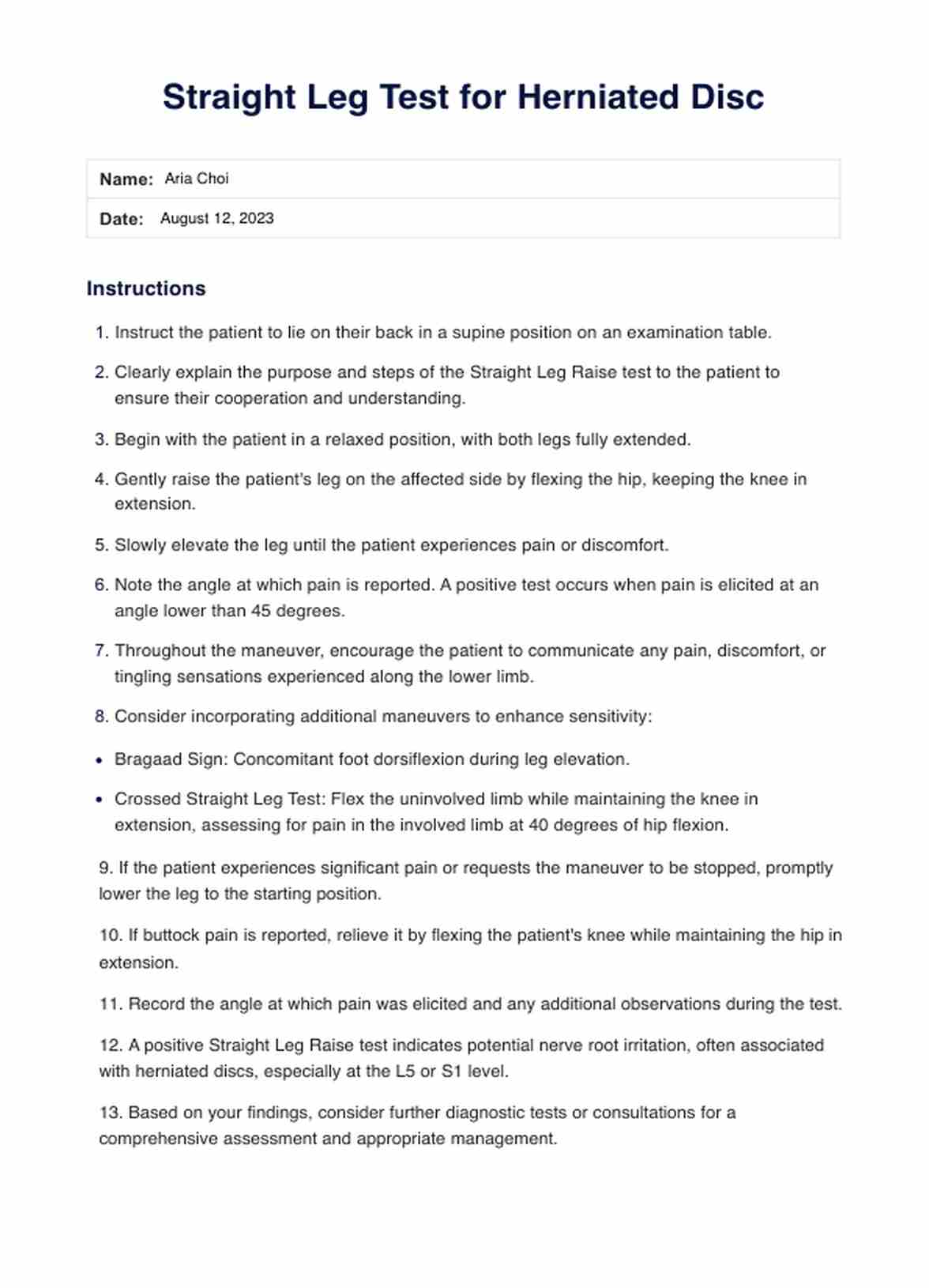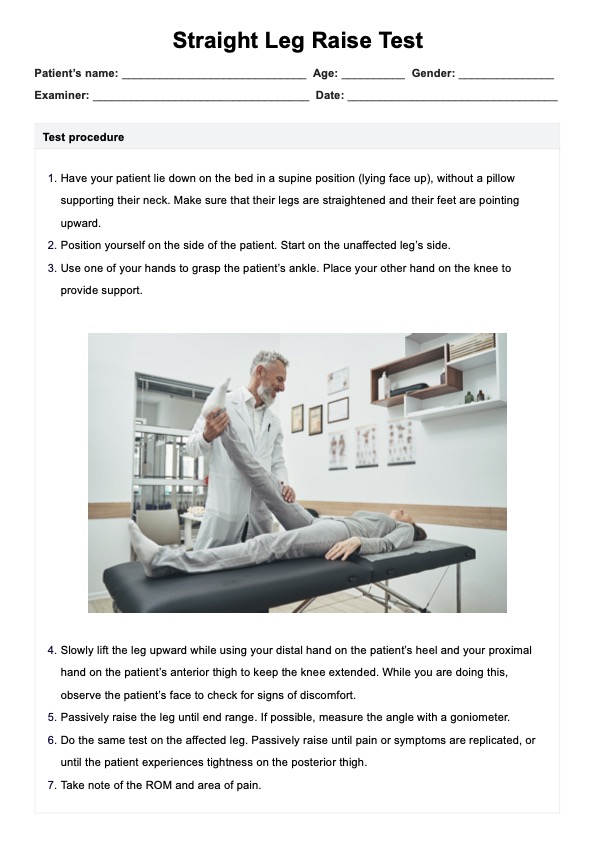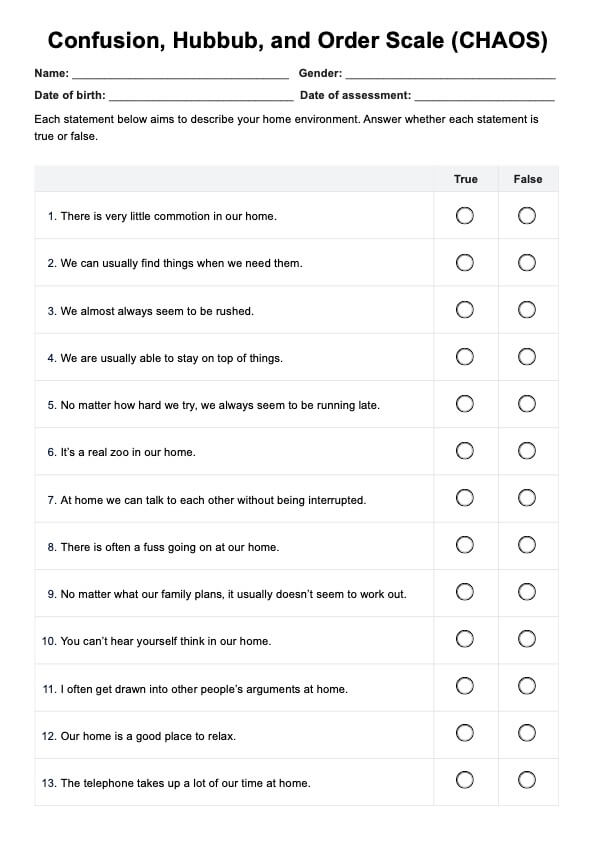Straight Leg Test for Herniated Disc
Download a free Straight Leg Test for Herniated Disc template. Learn how to perform the test and streamline your clinical documentation.


What is a herniated disc?
A herniated disc, also referred to as a slipped or bulging disc, is a condition that occurs when the soft inner part of an intervertebral disc protrudes through the tough outer layer known as the annulus fibrosus. This protrusion can exert pressure on nearby nerves, leading to symptoms such as pain, tingling, or numbness in the affected area.
The development of herniated discs is often associated with age-related degeneration of the spine. Over time, the discs lose their water content and elasticity, making them more susceptible to injury and herniation. However, such disc herniations can also be triggered by sudden trauma or injury to the spine.
While herniated discs most commonly manifest in the lumbar (lower back) region due to the significant weight-bearing and mobility demands placed on this area, they can also occur in the cervical (neck) region. Proper diagnosis and treatment are crucial to managing symptoms and preventing potential complications associated with herniated discs.
Straight Leg Test for Herniated Disc Template
Straight Leg Test for Herniated Disc Example
Symptoms of a herniated disc
The symptoms of a herniated disc can vary significantly from person to person depending on several factors, such as the location of the herniation and the degree of nerve root compression. Some common symptoms include:
- Low back pain: Often the first symptom experienced, low back pain can range from mild to severe and may increase with movement.
- Leg pain: In the case of lumbar disc herniation, the pain is usually more pronounced in the legs than in the lower back. The herniated material can press against lumbar nerve roots, affecting the legs.
- Numbness or tingling: These sensations may occur in the area of the body served by the affected nerves, often felt in the legs or feet for lumbar disc herniations.
- Strength loss: Weakness in the muscles served by the irritated nerves can manifest, affecting mobility or the ability to hold or lift items.
What is the Straight Leg Test for Herniated Disc?
The Straight Leg Test, or the straight leg raise test, is a diagnostic technique commonly employed to assess the likelihood of a herniated disc in the lumbar region. This procedure requires the individual to lie supine while a medical practitioner gently elevates the patient's leg separately, maintaining it in a fully extended position.
Should discomfort manifest in the leg being raised upon reaching a specific degree of elevation, this may suggest the presence of a herniated disc requiring further evaluation.
Healthcare professionals may also perform additional diagnostic evaluations, such as magnetic resonance imaging (MRI), CT scan, clinical neurological examination, or nerve conduction studies, to confirm the presence of a herniated disc and determine the extent of nerve damage.
How does our Straight Leg Test for Herniated Disc template work?
Our Straight Leg Test for Herniated Disc template contains step-by-step instructions adapted from Carmino and Piuzzi's straight leg test (2019), helping you perform the assessment accurately and consistently. Follow these steps to get started:
Step 1: Download the straight leg raising test template
Get a copy of our printable template using the link on this page. You can also access it via the Carepatron app or our resources library.
Step 2: Conduct the physical examination
Follow the instructions on the template to help guide you through the physical examination process. Ensure that the affected leg is thoroughly examined where the patient reports pain to assess the severity and location of potential nerve damage.
Step 3: Record the results
Use the designated space on the template to record your findings. This will help you keep track of any changes in symptoms over time and can also serve as a reference for future medical appointments.
Step 4: Determine next steps
Based on your results, determine if further diagnostic evaluations are necessary. Positive test results may indicate the need for additional magnetic resonance imaging evidence (MRI) or nerve conduction studies to confirm a herniated disc diagnosis and determine the extent of nerve damage.
Step 5: Follow up with the patient
Follow up with the patient after conducting the test and completing additional evaluations. This will help you monitor their progress and adjust their treatment plan.
Using this straight leg raise test template can boost your practice and client success. It helps clients outline actionable strategies for improvement.
Treatment options for a herniated disc
The recommended course of treatment for a herniated disc will depend on the severity and location of the condition and the individual's overall health. Some standard treatment options include:
- Rest and physical therapy: In mild cases, resting and engaging in physical therapy exercises may help alleviate symptoms.
- Medications: Over-the-counter pain relievers can help manage pain and inflammation. Doctors may prescribe stronger pain medications or muscle relaxants in more severe cases.
- Epidural steroid injections (ESIs): These injections deliver anti-inflammatory medication directly to the affected area, providing temporary relief from symptoms.
- Surgery: If conservative treatments do not provide relief, surgery may be recommended. A discectomy involves removing a portion of the herniated disc that is pressing on a nerve.
Preventing herniated discs
While not all herniated discs can be prevented, some steps can be taken to reduce the risk of developing this condition. These include:
- Maintaining a good posture: Poor posture can strain the spine and increase the risk of disc problems.
- Avoiding heavy lifting: Lifting heavy objects improperly can put excessive pressure on the spine and increase the risk of a herniated disc.
- Engaging in regular exercise: Staying active can help strengthen the muscles that support the spine, reducing the risk of disc problems.
- Practicing proper lifting techniques: When lifting objects, it is essential to use your legs instead of your back and to avoid twisting motions.
Reference
Camino, G. O., & Piuzzi, N. S. (2019, September 10). Straight Leg Raise Test. Nih.gov; StatPearls Publishing. https://www.ncbi.nlm.nih.gov/books/NBK539717/
Commonly asked questions
The straight leg raise test involves lifting one leg while lying on your back to check for signs of nerve root irritation. The crossed straight leg test is a modification that involves crossing the legs at the ankles and performing the same movement.
Limited hip flexion can indicate the presence of a herniated disc. During the physical assessment, if a patient experiences increased pain or discomfort when attempting to flex the hip, it could be a sign of lumbar nerve root compression or severe nerve root irritation, often associated with herniated discs.
Yes, herniated discs can cause severe nerve root irritation, characterized by sharp or burning pain radiating down the leg, weakness, or numbness in the affected area. Diagnostic tests, such as MRI or CT scans and physical exams, are used to identify nerve root irritation and its severity.
Yes, a positive straight leg raise test can specifically indicate sciatic nerve irritation. During the test, if lifting the straight leg produces pain along the sciatic nerve distribution, it suggests that the sciatic nerve is irritated or compressed, often due to underlying conditions such as a lumbar herniated disc.












































































































